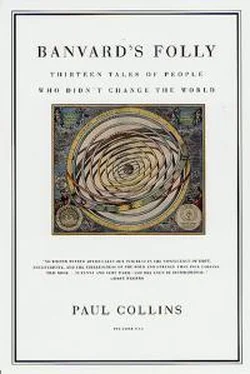The two men from the Massachusetts Horticultural Society walked up to his cottage door one September day.
"Where are those grapes you promised to send in?"
Bull was taken aback.
"I did send them in, by a neighbor" he stammered. "I was too sick to make the trip myself, but I sent them just as I said I would."
The men said they'd check the exhibition tables at Horticultural Hall again. A lot was riding on their finding that bunch of grapes; the 1853 fall meeting in Boston of the Horticultural Society was to be the Concord's public debut. And it took some searching, but they were there--just as Bull said they'd be.
They'd been mistakenly placed in the vegetable section instead, and hidden under a pile of squashes and turnips. The mistake was understandable, because the Concords didn't even look like grapes--not to American eyes, anyway. They were too big.
The judges raised their eyebrows.
"I'll bet he girdled the vines," ventured one. "We'd better make sure there's no trickery here."
And so the committee rode out to Concord and made the pilgrimage out to Grapevine Cottage. Bull, already too sick to make the Boston meeting, now found himself surrounded by men with notebooks, peppered on all sides by questions. How had he raised the vines? were these really typical grapes for this variety? Could he prove it?
--There are others out back.
And Bull led them out to his vineyard, where the judges examined the vines.
Not only had Bull sent them entirely typical specimens, but the grapes in his backyard were even bigger ... and sweeter.
Bull was fairly matter-of-fact in his own descriptions of what he had sown: The grape is large, frequently an inch in diameter, and bunches handsomely shouldered, and sometimes weigh a pound. In color it is ruddy black, covered with a dense blue bloom, the skin very thin, the juice abundant, with a sweet aromatic flavor. It has very little pulp. The wood is strong, the foliage large, thick, strongly nerved, with a woolly under surface, and does not mildew or rust. It ripens the 10th of September.
But a reporter at the exhibition was more to the point: "The committee announced to the world that, at last, a grape had been developed that would grow in New England--bigger and better than any grown before."
Bull's vine stock soon went on sale, available only through C. M. Hovey and Company of Boston. Bull and Hovey were sitting on a gold mine--as the only sellers of what promised to be the greatest American vine ever bred, they could charge $5 a vine and see a handsome profit. It was a tremendous hit: requests poured in from amateur viticulturists from around the country, and in 1854 alone Bull's cut was $3,200. Concord grapes were destined, it seemed, to appear on every backyard trellis in the country.
But then something strange happened. Sales went down--just a little at first.
Then a little more. And then, inexorably, the sales dwindled to nearly nothing. The realization slowly sank into Bull: it wasn't just amateurs who had been sending in orders to Hovey.
His competitors had been buying the vines.
There was no way that Bull could have anticipated what happened. Grapes were not a commercial crop in the United States. But the reporter at the exhibition had been right: the judging committee had told the world, perhaps a little too well, just how fine Bull's grapes were. And now commercial nurseries, who'd never bothered much with grapevines before, were quietly ordering the Concord vine and preparing enough to seed an entire domestic industry--all without a penny to go to Ephraim Bull.
In 1854, breeders in the United States had no protection whatsoever, no way to control their product. They could thank Thomas Jefferson for this: when drafting the country's patent laws, he had deliberately excluded life forms.
Perhaps it seemed impious to claim the mantle of creation over life itself.
But then again, Jefferson was a levelheaded Deist, a man who never let a religious qualm derail a rational train of thought. His real reason for excluding life forms might have been simple: to keep the courts from becoming solidified into a frozen block of litigation. It wasn't until 1930 that Congress finally allowed plant varieties to be patented.
What was more, patents didn't always protect the holders anyway. Quite the reverse: if you were patenting a mechanical process, your patent papers would have to describe the workings in great detail. Any crook willing to read through the public record could swipe your invention, secure in the knowledge that if the patent holder lived far enough away, he might never even find out--and even if he did, he might not be able to afford a legal battle. Some of the greatest and most lucrative inventions were never patented at all, and for precisely this reason.
When Scientific American readers were asked in 1899 to name the greatest invention of their century--they had tiresome lists and "best of" century wrap-ups back then, too--it was not Bell's telephone that they named. Nor, for that matter, was it Edison's lightbulb, Whitney's cotton gin, Fulton's steam engine, or photography, or the gas-powered automobile, or any other of a multitude of obvious choices. It was the Bessemer steel process.
Sir Henry Bessemer is a man little spoken of today, but his steel process, which he was perfecting even as Ephraim Bull was happily cashing his first big check from Hovey and Company, built the modern world as we know it. Virtually all steel--whether in cars or buildings--is manufactured on some variant of the Bessemer process. Sir Henry became fantastically wealthy off it. But this was not how made his first fortune.
His first fortune came from, of all things, powdered bronze. As a young man, Bessemer was helping his sister decorate a portfolio of flower illustrations.
He needed some gold ink to complete the lettering, and to do this, he'd have to get some "gold powder" from Mr. Clark, the local art supply merchant:
The material was not called "gold," but "bronze" powder, and I ordered an ounce of each shade of colour, for which I was to call on the following day. I did so, and was greatly astonished to find that I had to pay seven shillings per ounce for it.
On my way home, I could not help asking myself, over and over again, "How can this simple metallic powder cost so much money?" for there cannot be gold enough in it, even at that price, to give it this beautiful rich colour. It is, probably, only a better sort of brass; and for brass in almost any conceivable form, seven shillings per ounce is a marvellous price ....
Here was powdered brass selling retail at l5 12s. per pound, while the raw material from which it was made cost probably no more than sixpence. "It must, surely," I thought, "be made slowly and laboriously, by some old-fashioned hand process; and if so, it offers a splendid opportunity for any mechanic who can devise a machine capable of producing it simply by power."
The powder, it turned out, was manufactured secretly in Nuremberg. Bessemer found the formula in an old tome at the British Museum, and it was every bit as laborious as he'd guessed--so much so that the only way to better it was to leapfrog it entirely, to invent bronze powder anew. After much experimentation, Bessemer devised an engine that ground out bronze powder far faster than any current process. When he showed the results to one importer, the man offered him l500 yearly on the spot for use of the process.
That is when Bessemer knew it must be worth a great deal more than l500.
Moreover, he knew that as soon as he filed a patent, he probably wouldn't even see l500 off it. He'd have to keep it secret. But how?
There were powerful machines of many tons in weight to be made; some of them were necessarily very complicated, and somebody must know for whom they were
Читать дальше











